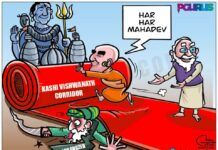
[dropcap color=”#008040″ boxed=”yes” boxed_radius=”8px” class=”” id=””]W[/dropcap]ith Saif Ali Khan and Kareena Kapoor naming their newly born son Taimur Ali Khan Pataudi, I began to think what kind of non-Muslim woman would like her son to be known by the name reminiscent of one of the most brutal conquerors of the world. Taimur, Timur, or Tamerlane slaughtered 5 per cent of the people of the world, built towers of skulls, and massacred one lakh people in Delhi alone. And the celebrity couple is commemorating that monster!
The Mughal kings, for instance, claimed to be the descendants of Taimur.
They, however, are not alone glorifying the great butcher. He is generally regarded as a hero in the Muslim world, as Sword of Islam. The Mughal kings, for instance, claimed to be the descendants of Taimur.
Coming back to the question of Kareena acceding to name her son as Taimur—and in general non-Muslim women embracing Islam to marry a Muslim—the explanation lies in the portrayal of Islam. Whether it is textbooks, especially in India, or the mass media, the religion is misrepresented.
Let’s begin with concrete examples. The history book for high school students, The Story of Civilization (Party I), by Arjun Dev, depicts the rise of Islam in soft focus. At the time of Prophet Muhammad, “Arabia was a land of superstition and ignorance.” He challenged the status quo and established a new, egalitarian religion: “Muslims all over the world over regard themselves as brothers and equals.”
After a brief description about Islamic beliefs, principles, and practices, the book tells impressionable students, “The emphasis on a life of virtue and benevolence makes Islam one of the great humanitarian religions. The holy book of the Muslims, the Quran, emphasizes such virtues as ‘to free the captive, or to feed, in a day of famine, the orphan who is of kin, or the poor man who lies on the ground’.”
[dropcap color=”#008040″ boxed=”yes” boxed_radius=”8px” class=”” id=””]T[/dropcap]here is complete absence of criticism of the Prophet and his followers: how the unbelievers were slaughtered and forcibly converted, how the Jews were betrayed and oppressed, how the Quran exhorts the faithful to kill the infidel and subdue women, how slavery was institutionalized, how sex slavery was countenanced, and so on.
The conflict between the 10 Sikh Gurus and the Mughal rulers was religious rather than personal and political; for the former were mostly preachers and not politicians aggrandizing their power;
Scholarly sophistry was also used to whitewash the bloody history of Islam in India. Medieval India by Satish Chandra, meant for Class XI students, says, “Thus, there was no atmosphere of confrontation between the Sikhs and the Mughal rulers during this period. Nor was there any systematic persecution of the Hindus, and hence, no occasion for the Sikhs or any group or sect to stand forth as the champion of the Hindus against religious persecution. The occasional conflict between the Gurus and the Mughal rulers was personal and political rather than religious. Despite some display of orthodoxy by Shah Jahan at the beginning of his reign and a few acts of intolerance, such as the demolition of ‘new’ temples, he was no narrow in his outlook which was further tempered towards the end of his reign by the influence of his liberal son, Dara.”
All this is chicanery, for there was an atmosphere of confrontation between the Sikhs and the Mughal rulers. The conflict between the 10 Sikh Gurus and the Mughal rulers was religious rather than personal and political; for the former were mostly preachers and not politicians aggrandizing their power; only the later Gurus took recourse to arms, and that too to fight jihadist excesses and not to enjoy power and pelf.
The most tyrannical and bigoted Mughal Emperor, Aurangzeb, is also provided covering fire by Left-leaning historians. So, according to Chandra, the re-imposition of the hated jizya “was not meant to an economic pressure for forcing Hindus to convert to Islam, for its incidence was to be light.” He went on to list the exempted categories—women, children, disabled, the indigent, etc. Further, it was “to be collected by honest, God-fearing Muslims who were specially appointed for the purpose and its proceeds were reserved for the Ulema.”
[dropcap color=”#008040″ boxed=”yes” boxed_radius=”8px” class=”” id=””]C[/dropcap]handra also emphasizes that the factors responsible for the re-imposition of jizya were not religious but “political and ideological.” The idea was “to rally the Muslims for the defence of the State against the Marathas and the Rajputs…” If rallying the faithful against the infidels like the Marathas and Rajputs is not a religious call, nothing else is.
Chandra shielded not only Aurangzeb and other Mughals but also the barbaric Sultanate rulers before them.
The historian’s explanation of Aurangzeb’s temple-destruction spree is an exercise in the most reprehensible form of casuistry. He offers even the most untenable excuses to shield the emperor from flak: his motivations were political; “it is wrong to think that there were any orders for the general destruction of temples”; there were instigations from “local elements.”
Chandra shielded not only Aurangzeb and other Mughals but also the barbaric Sultanate rulers before them. The sultans, we are told, followed a “policy of broad toleration.”
Let’s see what Amir Khusru (1253-1325), or Amīr Khusrow, wrote. He was a Sufi musician, poet, and scholar. He is lionized as a symbol of composite culture—which is the desi term for multiculturalism. But he was also, as the historian Sita Ram Goel rightfully described him, “the lick-spittle of whoever came out victorious in the contest for the throne at Delhi”—a trait common in many intellectuals of contemporary India as well. According to Goel, “Amir Khusru describes with great glee how the heads of Brahmans ‘danced from their necks and fell to the ground at their feet,’ along with those of the other ‘infidels’ whom Malik Kafur had slaughtered during the sack of the temples at Chidambaram.”
Goel has also quoted passages from Khusru. “When the royal army [of Alau’din Khalji] reached that province [Gujarat], it won a victory after great slaughter… The army of Islam broke the idols [at Somnath] and the biggest idol was sent to the court of the Sultan.” This is Khusru—the icon of inter-religious faith! Goel wonders “whether the poet of Islam is being honored or slandered when he is presented in our own times as the pioneer of Secularism.”
[dropcap color=”#008040″ boxed=”yes” boxed_radius=”8px” class=”” id=””]I[/dropcap]t gave great joy to Khusru to see the Islamic conquest of Deccan and South India: “The tongue of the sword of the Khalifa of the time, which is the tongue of the flame of Islam, has imparted light to the entire darkness of Hindustan by the illumination of its guidance… the army has conquered from sea to sea, and several capitals of the gods of the Hindus in which Satanism had prevailed since the time of the Jinns, have been demolished. All these impurities of infidelity have been cleansed by the Sultan’s destruction of idol temples, beginning with his first expedition against Deogir, so that the flames of the light of the law illuminate all these unholy countries, and places for the cries to prayers are exalted on high, and prayers are read in mosques. God be praised!” So much for composite culture and communal harmony.
India’s contemporary historians have played their pernicious role of concealing the truth and Islamic barbarity and spreading lies…
So much for the policy of broad toleration.
In other words, India’s contemporary historians have played their pernicious role of concealing the truth and Islamic barbarity and spreading lies; this has made the minds of non-Muslim girls and boys vulnerable to the myths like ‘Islam is a religion of peace’ and ‘all religions preach harmony.’ The role of public intellectuals, including that of media Brahmins, has been no less dangerous. These folks hate all religions except Islam, so they do their best to keep Islam away from the taint of terror, misogyny, bigotry, etc. Often the names of the perpetrators of terror attacks are withheld. Another ruse is to link terror with non-religious factors like racism, alienation of minorities, unemployment, and poverty.
Therefore, it is not surprising that many non-Muslim women embrace Islam to marry a Muslim, without realizing that it is akin to a Jew joining the Nazi Party. And Kareena Kapoor finds nothing objectionable in naming her son as Taimur.
Editor’s comments: Naming their child is their personal matter. However, the couple should give thought to what could happen as their son grows up and is teased for his name by his peers.
Note:
1. Text in Blue points to additional data on the topic.
2. The views expressed here are those of the author and do not necessarily represent or reflect the views of PGurus.
- Liberty Is Penalized, Violence Goes Untouched - December 21, 2019
- Rahul’s Howdy bloomer - September 22, 2019
- Chidambaram’s hypocrisy - August 22, 2019











All said and done, the world would have been much better place without any Islam in it. All religions have undergone change and reform, but even to talk of that in Islam is akin to inviting death. Indeed, Islam is a death cult. Period.
“Arabia was a land of superstition and ignorance.” He challenged the status quo and established a new, egalitarian religion: “Muslims all over the world over regard themselves as brothers and equals.”
How is replacing one superstition with another bloodier and more violent superstition laudable?
I think naming the child as taimur is deliberate. With the hindu identity on the raise, the muslims want to register their supremacy. So, this naming business is emphatic reminder to the Hindus about who the boss is.